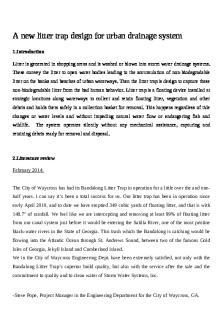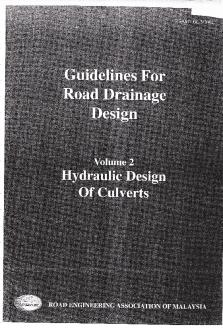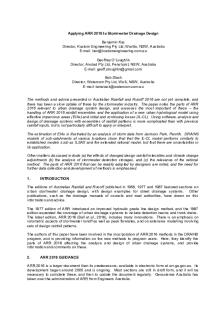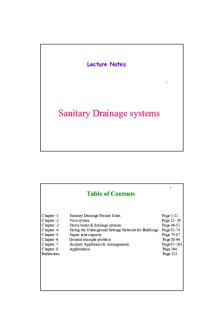THE DESIGN OF A NEW KATANGA DRAINAGE PDF

| Title | THE DESIGN OF A NEW KATANGA DRAINAGE |
|---|---|
| Author | Sulaiman Bbaale |
| Pages | 106 |
| File Size | 9.3 MB |
| File Type | |
| Total Downloads | 425 |
| Total Views | 1,015 |
Summary
MAKERERE UNIVERSITY COLLEGE OF ENGINEERING, DESIGN, ART AND TECHNOLOGY SCHOOL OF ENGINEERING DEPARTMENT OF CIVIL AND ENVIRONMENTAL ENGINEERING CIV 3202 GROUP DESIGN PROJECT REPORT FOR THE DESIGN OF A NEW KATANGA DRAINAGE CHANNEL GROUP 2 NAME STUDENT NUMBER REGISTRATION NUMBER BBAALE SULAIMAN 2140015...
Description
Accelerat ing t he world's research.
THE DESIGN OF A NEW KATANGA DRAINAGE Sulaiman Bbaale
Related papers
Download a PDF Pack of t he best relat ed papers
St ormwat er Report Ayodele Raji Hydrology - Principles, Analysis, Design Amel Jojo Causes and Effect s of Poor Drainage Syst em on t he Asphalt Pavement Layer: a Case St udy robi diriba
MAKERERE
UNIVERSITY
COLLEGE OF ENGINEERING, DESIGN, ART AND TECHNOLOGY SCHOOL OF ENGINEERING DEPARTMENT OF CIVIL AND ENVIRONMENTAL ENGINEERING CIV 3202 GROUP DESIGN PROJECT REPORT FOR THE DESIGN OF A NEW KATANGA DRAINAGE CHANNEL
GROUP 2 NAME BBAALE SULAIMAN GUMISIRIZA SUNDAY SAMUEL KINSAMBWE DESMOND ELIJAH NAMANYA DERRICK TIBAINGANA BRIAN KITARA VIVIAN MUGABE BRIGHTON OCHIENG FRANCIS XAVIER AIJUKA NICHOLAS KATEMBESA ANTHONY OTIM ALVIN MUGISA ALOYSISUS KALIBBALA IBRAHIM
STUDENT NUMBER 214001528 214023267 214005085 214014333 214001314 211004460 214000510 214000766 214004301 214014207 214000770 213005126 213023078
SUPERVISOR: DR CHARLES NIWAGABA …………………………………………………..
REGISTRATION NUMBER 14/U/179 14/U/23211/PS 14/U/7925/PS 14/U/11919/PSA 14/U/1215 14/U/23351/PSA 14/U/633 14/U/1027 14/U/4500/PSA 14/U/7296/PSA 14/U/1080 13/U/8372/PSA 13/U/21891/PS
APPROVAL This report has been produced under the supervision and guidance of our supervisor, and the signature below will serve to attest to the credibility of that assertion.
Signature: ………………….
Date: …………………….
DR. CHARLES NIWAGABA SUPERVISOR
i
ACKNOWLEDGEMENT As it is often said, life is mixture of achievements, failures, experiences, exposures and efforts to make your dream come true. There people around you who help you realize your dream. Hence it’s our pleasure to be indebted to various people, who directly or indirectly contributed in the development of this work and who influenced our thinking, behavior, and acts during the project design. i.
First and foremost, we would like to thank the Almighty God who enabled us to finish this project design work and report successfully and above all, for giving us the wisdom and energy to execute the site works.
ii.
We would also wish to extend our sincere gratitude to our supervisor Dr. Charles Niwagaba for his dedication and guidance during the project design.
iii.
Special thanks also goes to Dr. Albert Rugumayo for the willingness to share knowledge and being there for consultation when we needed him especially when we were stuck.
iv.
Appreciation goes to the college of engineering, design, art and technology and Makerere University in general for giving us this opportunity to go out there and learn on our own in different sectors of civil engineering.
v.
Finally, we appreciate all those who contributed to the success and the preparation of this report and project design at large but not mentioned here.
ii
PREFACE Katanga slum is located in Kampala, Uganda, 2 kilometers from the city center and the slum has now existed for over 25 years. A recent (2014) census found that 20,000 people live in the condensed community. The area has become over populated and this has drastically increased surface runoff in its catchment. As a result, the existing drainage structures are no longer sufficient to accommodate the fast moving and enormous volume of runoff which has caused overflows and overspills. In addition, Solid waste collection and disposal is practically non-existent in the area as people use the existing drainage channel as the disposal point which silts it and also poses an immediate health hazard to the inhabitants The main drainage channel in Katanga catchment is a natural earth channel approx. 0.7km and it originates from public service, spans through the slums of Katanga and ends at Kubbiri. It’s the major channel in Katanga slum but unfortunately, the channel is highly silted, filled with garbage and sewage from burst sewage pipes from nearby sewers and it acts as a latrine and bathroom to many of the Katanga residents which has greatly reduced its capacity and also poses a serious outbreak of an epidemic due to poor sanitary conditions. Basing on the above mentioned challenges, we found it befitting to come up with an appropriate design of a new Katanga drainage channel from the existing natural earth channel. A reconnaissance survey was conducted which involved visiting the site and interactions with the community about this channel A topographic survey was conducted with help of a total station and reflectors to obtain coordinates used in the generation of topographic map. The coordinates were imported into ArcGIS enabling the generation and measurement of the channel’s watershed. The 10-year return-period design storm was determined with the aid of rainfall data for the catchment. The time of concentration was calculated, the critical rainfall intensity read off from the developed intensity-duration-frequency curves and the peak runoff calculated, using the rational method. The report shows detailed hydraulic calculations using manning’s formula. A trapezoidal channel section was chosen since it has greatest wetted perimeter. A concrete lining was proposed for the entire length of the channel. A freeboard of 0.5 above the normal water surface level was provided. The cost of the project was estimated at 5.25 Billion Uganda shillings after factoring in the projected costs to be incurred in the execution of the project. Recommendations to ensure that all the project objectives are met were stated.
iii
ALLOCATION OF TASKS The allocation of tasks in report preparation were as follows NAME BBAALE SULAIMAN
OTIM ALVIN
MUGABE BRIGHTON
KINSAMBWE DESMOND ELIJAH
GUMISIRIZA SUNDAY SAMUEL
MUGISA ALOYSIOUS
KITARA VIVIAN
KATEMBESA ANTHONY
TASK Presentation of the design
Presentation of the introduction
General compilation and typesetting of the proposal and report
Surveying
Presentation of the design
Presentation of the introduction
General compilation and typesetting of the proposal and report
Surveying
Presentation of the design
Presentation of the introduction
Surveying
Presentation of the methodology
Surveying
Obtaining necessary rainfall data.
Oral interview
Presentation of the methodology
Surveying
Oral interview
Presentation of the methodology
Surveying
Oral interview
Presentation of the conclusions and recommendations
General compilation and typesetting of the proposal and report
Surveying
Presentation of the methodology
General compilation and typesetting of the proposal and report
iv
OCHIENG FRANCIS XAVIER TIBAINGANA BRIAN NAMANYA DERRICK KALIBBALA IBRAHIM
AIJUKA NICHOLAS
Surveying
Presentation of the literature review
Surveying
Presentation of the literature review
Surveying
Presentation of the literature review
Surveying
Presentation of the literature review
Surveying
Oral interview.
Presentation of the design
Presentation of the introduction
Surveying
v
TABLE OF CONTENTS APPROVAL ................................................................................................................................................. i ACKNOWLEDGEMENT .......................................................................................................................... ii PREFACE................................................................................................................................................... iii ALLOCATION OF TASKS...................................................................................................................... iv CHAPTER ONE: INTRODUCTION ....................................................................................................... 1 1.1 BACKGROUND ................................................................................................................................ 1 1.3 JUSTIFICATION ............................................................................................................................... 2 1.4 AIMS AND OBJECTIVES1.4.1 MAIN OBJECTIVE....................................................................... 3 1.4.2 SPECIFIC OBJECTIVES ................................................................................................................ 3 1.5 SCOPE ................................................................................................................................................ 3 CHAPTER 2: LITERACTURE REVIEW ............................................................................................... 4 2.1 CHANNELS ....................................................................................................................................... 4 2.1.1 Natural channels............................................................................................................................... 4 2.1.2 Artificial channels ............................................................................................................................ 4 2.2 RAINFALL ....................................................................................................................................... 13 2.2.1 Convectional rainfall ...................................................................................................................... 13 2.2.2 Orographic/relief rainfall ............................................................................................................... 14 2.2.3 Cyclonic rainfall............................................................................................................................. 15 2.3 CATCHMENT/ WATERSHED ........................................................................................................... 15 2.4 RUNOFF ............................................................................................................................................... 15 2.4.1 Factors affecting runoff.................................................................................................................. 16 2.4.2 Methods for determining peak runoff ............................................................................................ 16 2.5 FLOODING ...................................................................................................................................... 20 2.6 CULVERTS ...................................................................................................................................... 20 2.7 ENVIRONMENTAL IMPACT ASSESSMENT ............................................................................. 20 2.8 GEOGRAPHIC INFORMATION .................................................................................................... 21 2.8.1 ArcGIS ........................................................................................................................................... 21 Hydraulic Toolbox .................................................................................................................................. 21 CHAPTER 3: METHODOLOGY ........................................................................................................... 22 3.1 RECONNAISSANCE SURVEY...................................................................................................... 22 3.1.1 Site Visit......................................................................................................................................... 22 3.1.2 Oral Interviews............................................................................................................................... 22 3.1.3 Channel Measurement.................................................................................................................... 23
vi
3.2 TOPOGRAPHC SURVEY ............................................................................................................... 24 3.3 THE TOPOGRAPHIC MAP ............................................................................................................ 25 3.4 THE CATCHMENT AREA ............................................................................................................. 26 3.5 THE DESIGN STORM .................................................................................................................... 28 3.5.1 Time of concentration ................................................................................................................ 28 3.5.2 Generation of the intensity duration frequency curves .................................................................. 30 3.5.3 Critical rainfall intensity ............................................................................................................ 36 3.5.4 Determining Peak runoff................................................................................................................ 36 3.6 DIMENSIONING THE CHANNEL ................................................................................................ 37 CHAPTER 4: CHANNEL DESIGN ....................................................................................................... 38 4.1 DESIGN STORM ............................................................................................................................. 38 4.1.1 Time of concentration .................................................................................................................... 38 4.1.2 Critical rainfall intensity ................................................................................................................ 38 4.2 DETERMINING PEAK RUNOFF ................................................................................................... 39 4.2.1 The coefficient of discharge ........................................................................................................... 39 4.2.2 The catchment areas ....................................................................................................................... 39 4.2.3 The peak discharges ....................................................................................................................... 40 4.3 DIMENSIONING THE CHANNEL ................................................................................................ 40 4.3.1 Depth of flow ................................................................................................................................. 41 4.3.2 Side Slope ...................................................................................................................................... 41 4.3.3 Channel Slope ................................................................................................................................ 41 4.3.4 Channel Lining material ................................................................................................................ 41 4.3.5 Channel Dimensions: ..................................................................................................................... 41 4.4 COST ESTIMATES ......................................................................................................................... 49 4.5 BILLS OF QUANTITIES................................................................................................................. 50 4.6 ENVIRONMENTAL AND SOCIAL IMPACT ASSESSMENT .................................................... 53 4.6.1 Impacts on the Environment. ......................................................................................................... 53 4.6.2 Social Impact Assessment .............................................................................................................. 55 4.7 OPERATION AND MAINTENANCE OF A DRAINAGE CHANNEL ........................................ 58 CHAPTER 5: CONCLUSION AND RECOMMENDATIONS ........................................................... 59 5.1 CONCLUSION ................................................................................................................................. 59 5.2 RECOMMENDTIONS ..................................................................................................................... 59 REFERENCES ........................................................................................................................................... 61 APPENDIX 2: DATA............................................................................................................................. 63 APPENDIX 3 : PICTURES .................................................................................................................... 90 vii
LIST OF TABLES Table 1: Open Channel Geometric Relationships for Various Crossections….………....7 Table 2: Table for few typical values of Manning’s n…………………………………..11 Table 3: Summary of the commonest responses to the questionnaire…………………...23 Table 4: Maximum daily rainfall………………………………………………….……..33 Table 5: Maximum Daily Rainfall for Return Period…………………………………....34 Table 6: Values of aT……………………………………………………………….........35 Table 7: Rainfall Intensities for Various Return Periods………………………………...36 Table 8: Typical Values of Rational Runoff Coefficients for Urban Areas ……………..38 Table 9: Land use areas in watershed…………………………………………………….40 Table 10: Recommended side slopes……………………………………………..………42 Table 11: maximum velocities for different channel linings……………………………..44 Table 12. Budget……………………………………………………………………….....63 Table 13: Work Plan………………………………………………………………….......63 Table 14: Maximum permissible velocity for selected lining materials………………….64 Table 15: Values of Constants in Intensity - Duration - Frequency Relationships….........65 Table 16: survey data……………………………………………………………………...67 Table 17: 15-Year Rainfall Data…………………………………………………………..74
viii
LIST OF FIGURES Figure 1: Photos showing current state of the channel……………………………….……….2 Figure 2: The span of the Katanga drainage channel……………………… …………………3 Figure 3: An open channel flow……………………………………………...… ……………5 Figure 4: Velocity distribution in an open channel…………………………….………… …..8 Figure 5: The formation of convectional rainfall……………………………..…… ………..14 Figure 6: The formation of relief rainfall………………………………………….…………..14 Figure 7: Formation of cyclonic rainfall……………………………………………………...15 Figure 8: Measurement of the channel lengths with help of a tape………………………......24 Figure 9: Measurement of the prism height………………………………………………..….25 Figure 10: Taking coordinates at chainage 0+420…………………………………………....25 Figure 11: Topographic map of the channel as obtained from civil 3D software……………..26 Figure 12: ArcGIS interface…………………………………………………………………....27 Figure 13: Illustration of the DEM……………………………………………….……………28 Figure 14: The catchment area…………………………………………………………………28 Figure 15: Graph of Max. Daily Rain against Return Period………………………………….29 Figure 16: the generated intensity duration curves…………………………………………… 36 Figu...
Similar Free PDFs
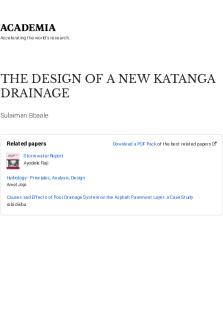
THE DESIGN OF A NEW KATANGA DRAINAGE
- 106 Pages
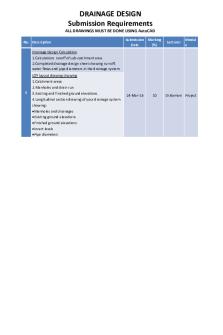
Drainage Design
- 43 Pages

URBAN DRAINAGE DESIGN MANUAL
- 478 Pages
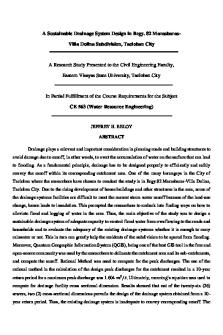
DRAINAGE SYSTEMS DESIGN
- 22 Pages

Drainage
- 7 Pages

The advantages of New Technology
- 2 Pages

The Rise of New Realism
- 3 Pages
Popular Institutions
- Tinajero National High School - Annex
- Politeknik Caltex Riau
- Yokohama City University
- SGT University
- University of Al-Qadisiyah
- Divine Word College of Vigan
- Techniek College Rotterdam
- Universidade de Santiago
- Universiti Teknologi MARA Cawangan Johor Kampus Pasir Gudang
- Poltekkes Kemenkes Yogyakarta
- Baguio City National High School
- Colegio san marcos
- preparatoria uno
- Centro de Bachillerato Tecnológico Industrial y de Servicios No. 107
- Dalian Maritime University
- Quang Trung Secondary School
- Colegio Tecnológico en Informática
- Corporación Regional de Educación Superior
- Grupo CEDVA
- Dar Al Uloom University
- Centro de Estudios Preuniversitarios de la Universidad Nacional de Ingeniería
- 上智大学
- Aakash International School, Nuna Majara
- San Felipe Neri Catholic School
- Kang Chiao International School - New Taipei City
- Misamis Occidental National High School
- Institución Educativa Escuela Normal Juan Ladrilleros
- Kolehiyo ng Pantukan
- Batanes State College
- Instituto Continental
- Sekolah Menengah Kejuruan Kesehatan Kaltara (Tarakan)
- Colegio de La Inmaculada Concepcion - Cebu
